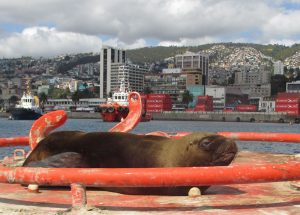 Valparaíso on the Pacific is the second port in Chile, after San Antonio. It is a renowned and extraordinary port city, because of its history, its colorful architecture and its location against the mountains. The harbor is a half round bay, with a container harbor, fishing boats, navy ships, cruise ships, bulk ships and a white sailing ship with four masts.
Valparaíso on the Pacific is the second port in Chile, after San Antonio. It is a renowned and extraordinary port city, because of its history, its colorful architecture and its location against the mountains. The harbor is a half round bay, with a container harbor, fishing boats, navy ships, cruise ships, bulk ships and a white sailing ship with four masts.
Chile is a peculiar country: it is more than four thousand kilometers long and about two hundred kilometers wide; it stretches from the dry and hot Atacama Desert in the north to the icy glaciers and fjords in the south. The country is sandwiched between the Pacific Ocean and the high Andes mountains. Chili is an Indian word and means: the end of the world. The Changos lived in the coastal area from about 1000 BC, making rafts from the skin of sea lions with which they went out to fish in the ocean.
In the mid-sixteenth century, the first Spanish ship anchored in the bay: the Santiaguillo, commanded by Juan de Saavedra, who named the place after his native village in Spain Valparaíso, meaning valley of paradise. A Spanish captain had all Changos killed in the Valparaíso area on the pretext that they were preparing an uprising.
After the discovery of the passage through South America via the Strait of Magellan, in 1520, and the more southern sailing route via Cape Horn in 1616, the significance of the port of Valparaíso increased. In 1817, Chile became independent from Spain. Valparaíso became a naval port, and many foreign merchants settled in the city. The discovery of gold in California in 1848 brought many adventurers from all over the world on ships to California, calling at Valparaíso along the way. The port grew, and this was especially true when nitrate was found on a large scale in the Atacama Desert in the north, a salt that served as fertilizer for poor and depleted agricultural areas in Europe, the United States and Asia. Valparaíso became an important nitrate port. The American sailing ships that came to fetch the nitrate brought large amounts of American pine, with which the wooden houses of the city were built, after which they got all possible cheerful colors of paint.Due to the construction of the Panama Canal in 1914, the cosmopolitan Valparaíso lost its strategic importance; international trade routes changed, ships no longer took the dangerous and long way via Cape Horn. Many entrepreneurs left the port to settle in Santiago.The 1973 coup against Socialist President Salvador Allende was orchestrated from the naval port of Valparaíso, with the help of US naval ships in the port coordinating the various army units. Chile had a repressive military dictatorship between 1973 and 1990. At the time, Chicago-educated economists forcibly introduced a neoliberal economy that sidelined unions, favored the wealthy elite, and turned the less privileged into second-class citizens. This neoliberal model was later implemented by technocrats in many countries in the world.
Currently, the port of Valparaíso is picking up again, due to an increase in cruise ships visiting the beautiful coastal area, and the arrival of giant Post-Panamax container ships that are too large to sail through the Panama Canal.




